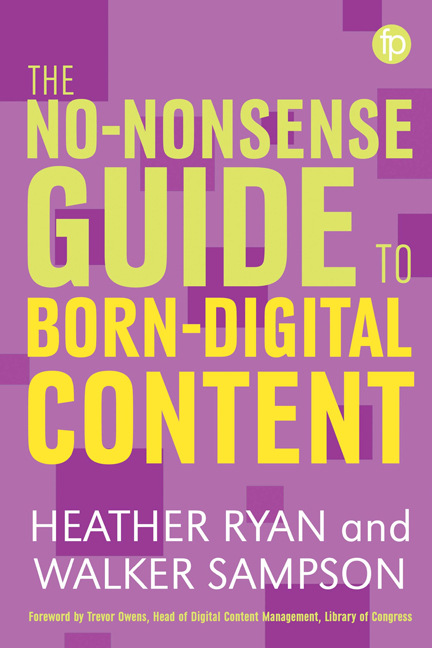Book contents
- Frontmatter
- Contents
- List of figures and tables
- Foreword
- Acknowledgements
- List of abbreviations
- Glossary
- Introduction
- 1 Digital information basics
- 2 Selection
- 3 Acquisition, accessioning and ingest
- 4 Description
- 5 Digital preservation storage and strategies
- 6 Access
- 7 Designing and implementing workflows
- 8 New and emerging areas in born-digital materials
- Conclusion
- References
- Appendix A Resources
- Appendix B Basic Unix command line prompts
- Index
3 - Acquisition, accessioning and ingest
Published online by Cambridge University Press: 08 June 2018
- Frontmatter
- Contents
- List of figures and tables
- Foreword
- Acknowledgements
- List of abbreviations
- Glossary
- Introduction
- 1 Digital information basics
- 2 Selection
- 3 Acquisition, accessioning and ingest
- 4 Description
- 5 Digital preservation storage and strategies
- 6 Access
- 7 Designing and implementing workflows
- 8 New and emerging areas in born-digital materials
- Conclusion
- References
- Appendix A Resources
- Appendix B Basic Unix command line prompts
- Index
Summary
There are libraries, archives and collections out there with floppies. They probably never got funding or time to take the data off – there's a great chance the floppies are considered plain old acquisition items and objects, like books or a brooch or a duvet cover. They're not.
(Jason Scott, ASCII blog, 2011)Now that we have discussed major appraising and collecting concerns, let's get into the specific work of acquiring, accessioning and ingesting borndigital content into an archives or library collection. Before we do so, bear with us as we define these terms and cover the high-level principles that guide born-digital acquisitions. For our purposes here, acquisition refers to the physical retrieval of digital content. This could describe acquiring files from a floppy drive, selecting files from a donor's hard drive or receiving files as an e-mail attachment from a donor. In all cases, you now have physical control of the content. Accessioning refers to integrating the content into your archives or collections: assigning an identifier to the accession, associating the accession with a collection and adding this administrative information into your inventory or collection management system. Ingest is the process of placing your content into whatever repository system you have for digital content. This could be any solution from a simple but consistent file and folder structure to a full stack of storage and content management software. While each of these processes can sometimes be done in a single step, we will cover each in turn, and by the end of the chapter you should have a comprehensive overview of the initial steps in any born-digital workflow.
Principles of acquisition
The principles of acquisition of born-digital content flow from the general guidelines for acquiring all archival material. Yes, that's right: respect des fonds is still the guiding light for handling born-digital content. The prin - ciple, issuing from Natalis de Wailly at the Royal Archives of France in 1841, advises the grouping of collections by the body (roughly, the ‘fonds’) under which they were created and purposed. The two natural objectives flowing from respect des fonds are the retention of both provenance and original order. These objectives really get to the heart of our concerns in acquiring born-digital content – we want to avoid tampering with original order or losing sight of provenance each step of the way.
- Type
- Chapter
- Information
- The No-nonsense Guide to Born-digital Content , pp. 53 - 86Publisher: FacetPrint publication year: 2018



